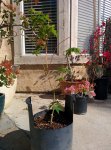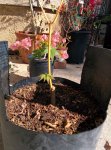symbiotic1
Mame
I have a young grafted japanese maple I bought last fall and disappointingly the graft is kind of high and not that attractive. It doesn't seem like it will ever look natural. I want to do something to fit rid of the grafted area entirely and start training some nice nebari and I'm wondering if there is a certain age or caliper a tree should get to before this can be done?
If I am able to start it now, I initially thought to add another 4 inches of soil then put a cd around it to trigger new roots and better nebari once it outgrows the hole. Is this a good way to go or should I try to layer it instead with a small pot around the trunk sitting on the original soil then plant the result on an inverted saucer?
If I am able to start it now, I initially thought to add another 4 inches of soil then put a cd around it to trigger new roots and better nebari once it outgrows the hole. Is this a good way to go or should I try to layer it instead with a small pot around the trunk sitting on the original soil then plant the result on an inverted saucer?



